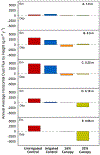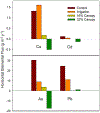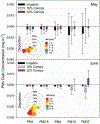Phytoremediation Reduces Dust Emissions from Metal(loid)-Contaminated Mine Tailings
- PMID: 29701964
- PMCID: PMC7025808
- DOI: 10.1021/acs.est.7b05730
Phytoremediation Reduces Dust Emissions from Metal(loid)-Contaminated Mine Tailings
Abstract
Environmental and health risk concerns relating to airborne particles from mining operations have focused primarily on smelting activities. However, there are only three active copper smelters and less than a dozen smelters for other metals compared to an estimated 500000 abandoned and unreclaimed hard rock mine tailings in the US that have the potential to generate dust. The problem can also extend to modern tailings impoundments, which may take decades to build and remain barren for the duration before subsequent reclamation. We examined the impact of vegetation cover and irrigation on dust emissions and metal(loid) transport from mine tailings during a phytoremediation field trial at the Iron King Mine and Humboldt Smelter Superfund (IKMHSS) site. Measurements of horizontal dust flux following phytoremediation reveals that vegetated plots with 16% and 32% canopy cover enabled an average dust deposition of 371.7 and 606.1 g m-2 y-1, respectively, in comparison to the control treatment which emitted dust at an average rate of 2323 g m-2 y-1. Horizontal dust flux and dust emissions from the vegetated field plots are comparable to emission rates in undisturbed grasslands. Further, phytoremediation was effective at reducing the concentration of fine particulates, including PM1, PM2.5, and PM4, which represent the airborne particulates with the greatest health risks and the greatest potential for long-distance transport. This study demonstrates that phytoremediation can substantially decrease dust emissions as well as the transport of windblown contaminants from mine tailings.
Figures





References
-
- Corriveau MC; Jamieson HE; Parsons MB; Campbell JL; Lanzirotti A Direct characterization of airborne particles associated with arsenic-rich mine tailings: Particle size, mineralogy and texture. Appl. Geochemistry 2011, 26 (9–10), 1639–1648.
-
- Meza-Figueroa D; Maier RM; de la O-Villanueva M; Gómez-Alvarez A; Moreno-Zazueta A; Rivera J; Campillo A; Grandlic CJ; Anaya R; Palafox-Reyes J The impact of unconfined mine tailings in residential areas from a mining town in a semi-arid environment: Nacozari, Sonora, Mexico. Chemosphere 2009, 77 (1), 140–147. - PMC - PubMed
-
- Ye ZH; Shu WS; Zhang ZQ; Lan CY; Wong MH Evaluation of major constraints to revegetation of lead/zinc mine tailings using bioassay techniques. Chemosphere 2002, 47 (10), 1103–1111. - PubMed
Publication types
MeSH terms
Substances
Grants and funding
LinkOut - more resources
Full Text Sources
Other Literature Sources
Research Materials

